HIGHLIGHTS: OCTOBER 25, 2024
• U.S. sustainability, cheese in spotlight at IDF WDS
• U.S. CDE holds first Vietnam-focused ingredients workshop
• Reaching health and wellness professionals at Korean Nutrition Society event
• Indonesia extends halal certification deadline
• U.S. cheese targets Saudi Arabia foodservice sector
• Comments urge USTR to address U.S. dairy trade concerns with EU
• USDEC outlines critical role of exports at DMI meeting
• All-Member Webinar: 2025 Operating Plan review
• Member Opportunity: USDA ag mission to Thailand
• New research! Whey study and beverage landscape in Southeast Asia report
• Market Summary: China WMP, SMP imports plummet in September
• NZ escalates Canadian dairy access challenge
• Almarai launches cheese production in Egypt
• Company briefs: Pure Ice Cream, Synlait, Great Lakes Cheese
Featured
U.S. dairy at the IDF World Dairy Summit
Strong representation by U.S. dairy farmers, USDEC and NMPF highlighted this year’s International Dairy Federation World Dairy Summit (IDF WDS), Oct. 15-18 in Paris. The annual global dairy event brings together a broad cross-section of dairy industry stakeholders, creating a platform for dairy farmers, processing companies, dairy researchers, dairy organizations and others to share success stories and discuss the challenges facing the sector.
This year’s focus was to strengthen attendees’ resolve to find increasingly sustainable solutions to meet growing demand, a goal embodied by the theme: “Proudly committed to a sustainable world.”
Several U.S. dairy farmers attended, including Marilyn Hershey, who represented the United States at an Organization for Economic Cooperation and Development event to discuss climate-smart commodities and spoke at the Dairy Leaders’ Forum on Sustainability. The U.S. delegation repeatedly made the point, echoed by others in attendance, that successful sustainability initiatives must both benefit the environment and be financially viable for dairy farmers.
“No one understands this better than U.S. dairy farmers,” said Krysta Harden. “Throughout the week, we heard several U.S. farmer leaders discuss real solutions and measurable progress they’ve made on their farms that illustrate U.S. dairy’s sustainability leadership in a way that supports their business bottom lines.”
USDEC’s presence at the summit helped elevate the farmer-to-farmer dialogue and the critical role of farmers as the world moves forward on sustainability.
Developments at WDS and beyond
Throughout the week, USDEC engaged with the international community and shared the U.S. dairy story in a variety of ways.
- Staff attended standing committee meetings representing USDEC on several workstreams in which IDF is engaged.
- USDEC held dedicated meetings with dairy sector representatives from Australia, Chile and the UK to discuss issues of mutual interest and coordinate efforts in support of dairy production, consumption and trade.
- U.S. cheese was featured prominently (see below) at the USDEC booth on the exhibit floor and a USDEC-organized Farmers Luncheon to discuss sustainability topics.
- USDEC member Tillamook County Creamery Association spoke on a panel on labor challenges facing the industry.
- USDEC’s Nick Gardner was elected as the Food Standards representative on the IDF Science and Programme Coordination Committee (SPCC). USDEC’s Shawna Morris continues her term on the SPCC as the representative for Dairy Policies & Economics.

U.S. dairy farmer Marilyn Hershey comments on U.S. dairy farm sustainability efforts during one of the technical sessions at this year’s IDF WDS.
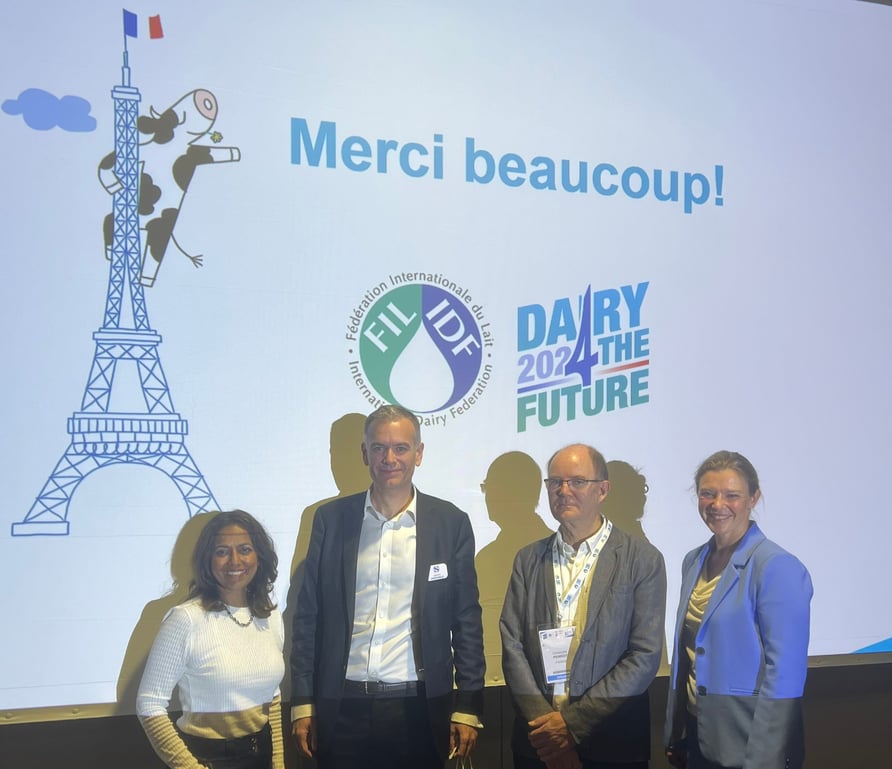
Tillamook County Creamery Association’s Sheila Murty (left) spoke on a panel on labor challenges in the dairy industry. She discussed strategies family-owned dairy cooperatives are using to address the issue.
Cheese spotlight
USDEC ensured that U.S. cheese had a high profile throughout the week. Staff members handed out cheese samples and provided information on U.S. cheese heritage and the broad portfolio of U.S. cheese varieties at the USDEC booth in the exhibit hall. The Farmers Luncheon on Oct. 16 featured a U.S. cheese tasting facilitated by Chef Antonio El Khoury, director of USDEC culinary programs in the Middle East/North Africa. USDEC topped it off with an Oct. 18 reception celebrating the world of dairy and the diversity of cheeses from the USA at the historic George C. Marshall Center at the Hôtel de Talleyrand. The reception aimed to bridge the two major dairy events taking place back-to-back in Paris: the IDF WDS and the SIAL Paris food exposition, which ran Oct. 17-21.
“Attendees who sampled the cheeses at the reception and elsewhere were extremely impressed by the quality and taste,” said Angelique Hollister, USDEC senior vice president, Global Cheese Marketing. “We won many U.S. cheese converts over the course of the two shows.”
USDEC would like to thank all those members who made that impression possible, including Belgioioso Cheese, Jasper Hill Farm, Rogue Creamery, Sartori, Schuman Cheese, Talmera USA and the California Milk Advisory Board, who all donated cheese. In addition, appreciation goes out to Dairy Farmers of Wisconsin and the Wisconsin Department of Agriculture, Trade and Consumer Promotion, who provided logistical support and USDA’s Foreign Agricultural Service office in Paris, which sponsored the Talleyrand venue.
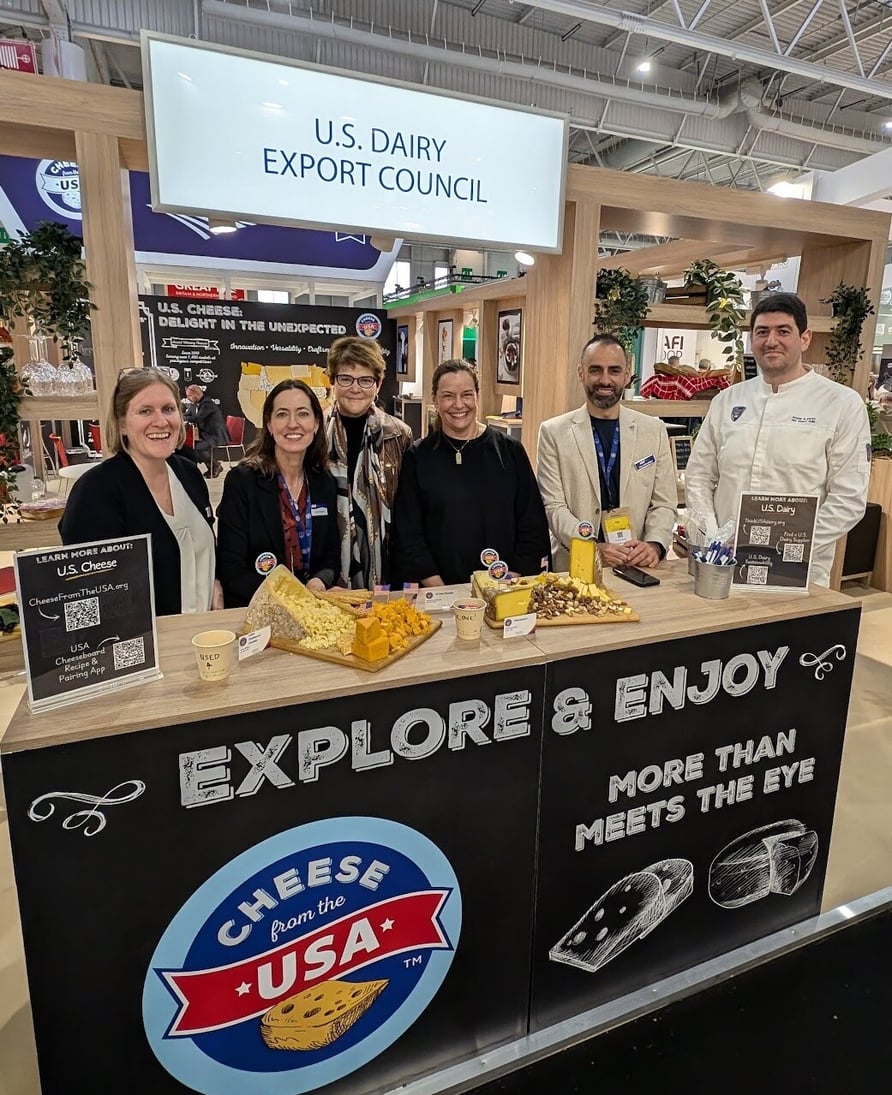
USDEC offered samples of U.S. cheese at the USDEC booth on the IDF WDS exhibit floor.

Left to Right: USDEC’s Kelly Sheridan, Krysta Harden, Nick Gardner, Martha Scott Poindexter and Janice Giddens at the USDEC cheese reception, which took place in the George C. Marshall Center at the Talleyrand Building.
First Vietnamese dairy ingredients workshop held at U.S. CDE
The U.S. Center for Dairy Excellence (U.S. CDE) notched a notable first last week: the debut U.S. dairy ingredient event specifically for a Vietnamese audience. Twenty-two R&D professionals from Vietnamese beverage manufacturers attended the two-day “U.S. Dairy Protein Beverage Innovation Workshop” on Oct. 16-17.
The workshop’s aim was to demonstrate how U.S. dairy protein ingredients could be used to create new and innovative beverage products geared to the tastes, nutritional needs and preferences of Vietnamese consumers. While protein was the predominant focus, attendees were also introduced to functional considerations for formulating with other U.S. dairy ingredients, including SMP and permeate.
The program was a true team effort between USDEC staff (from Vietnam, Singapore and Arlington) and USDEC members, as well as help from flavor supplier Takasago.
Day 1
Day 1 focused on U.S. dairy protein functionality, including specific insights on usage in both ready-to-drink and ready-to-mix products. Classroom instruction led by Martin Teo provided information on how to select and utilize the best dairy protein ingredient based on the beverage and addressed a range of functionality and performance considerations, from mouthfeel to hydration to pH stability. Teo later led a hands-on demonstration segment and tasting that included comparing samples made with dairy proteins alongside those made with certain plant proteins to evaluate the differences.
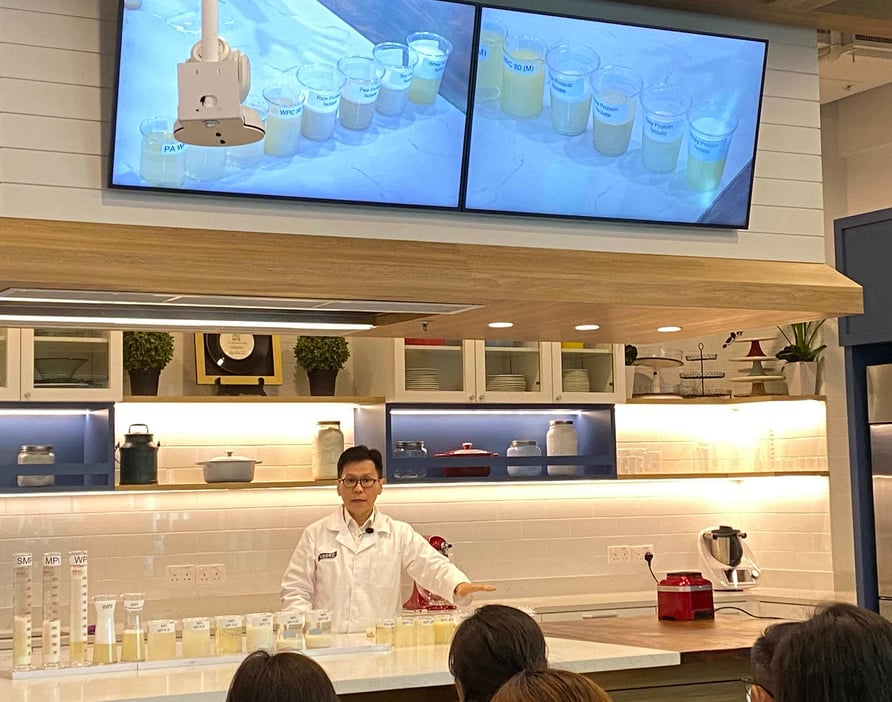
Martin Teo explores U.S. dairy ingredient functional considerations in beverage formulations, looking at factors like the pH level of the beverage and the ingredient’s foaming properties.

Calista Foo (far right) watches as two of the Vietnamese participants mix up a USDEC prototype beverage made with U.S. dairy protein for sampling.
Anoo Pothen provided insights into consumer beverage consumption behavior in Southeast Asia, with a particular focus on Vietnam.
Calista Foo and Rita Tay introduced USDEC beverage product concepts that align with key consumer behaviors, explaining how they crafted, tweaked and finalized production of the concepts.
Representatives from Takasago offered perspectives on flavor selection to align with U.S. dairy ingredients in beverage applications. They brought a line-up of prototypes they created (with USDEC’s help) for attendees to evaluate and learn how certain flavor selections help to compliment or mask tastes from U.S. dairy ingredients.
Keith Meyer, Kristi Saitama and Teo guided attendees through a showcase of commercial beverage products from the U.S., Northeast Asia and Southeast Asia—giving a sense of the diverse and growing product space to leverage dairy proteins, the extensive marketing opportunities, and numerous ways to meet evolving consumer needs and trends. They also highlighted success stories from previous Southeast Asian workshop participants who used their learnings to introduce new products.
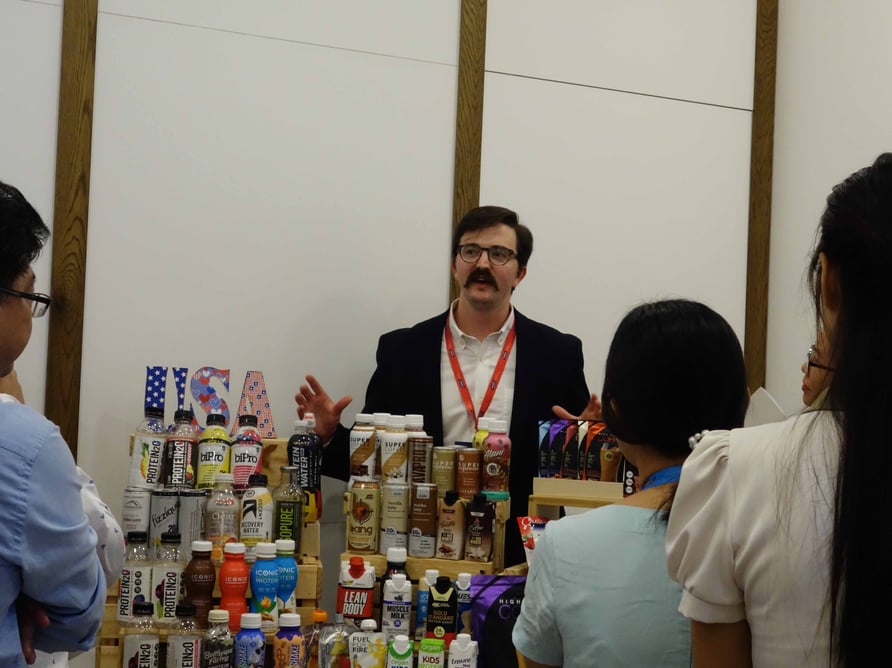
Keith Meyer reviews commercial beverage products made with dairy protein.
Day 2
Day 2 started with a session at Glanbia Nutritionals’ Collaboration Center in Singapore, where the group explored the facility’s capabilities and tasted a range of nutrition-oriented beverage product prototypes. They moved to the U.S. CDE for a hands-on experience crafting beverages with U.S. dairy proteins, using the information they received the previous day.
Meyer introduced some of the key advantages that set the U.S. apart as a source for the dairy ingredients the workshop participants learned about, including a committed network of suppliers investing in innovation and customer success as part of their own ambitious growth plans.
The workshop concluded with USDEC members connecting with attendees to discuss their portfolio advantages, opportunities for long-term partnerships and innovation.
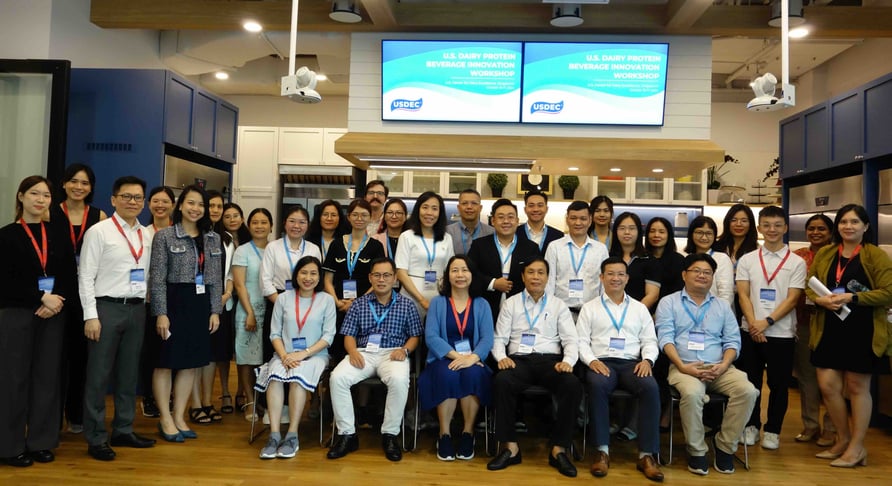
Vietnamese beverage R&D professionals, USDEC staff and other presenters from the U.S. Dairy Protein Beverage Innovation Workshop at the U.S. CDE.
USDEC stresses dairy protein benefits for later-life muscle health, mobility at Korean Nutrition Society conference
USDEC continued its ongoing health-and-wellness outreach in Korea at last week’s Korean Nutrition Society (KNS) Annual Meeting in Seoul. Nearly 500 KNS members attended the event.
KNS was founded in 1967 to improve public health and nutrition. The organization's membership includes professors and academic scholars in nutrition, medicine, pharmacology and other fields who are influential in establishing nutritional guidance in Korea. The 2023 conference theme was, “Nourishing Longevity: Integrating Nutrition into Strategies for Healthy Aging.”
Extensive U.S. dairy presence
USDEC sponsored a concurrent session—“Muscle Health and Mobility in Later Life”—within the KNS conference program, operated a booth to engage with KNS members, and took out a full-page ad in the conference program highlighting U.S. dairy protein nutritional quality and other advantages.
About 100 KNS members attended the one-and-a-half-hour concurrent session. The presentation highlighted the science-backed role that nutritionally complete and high-quality dairy proteins play in helping to reduce the risk of sarcopenia (the age-related, gradual decline of muscle mass and physical function).
It featured three speakers: Dr. Emily Arentson-Lantz, University of Texas Medical Branch; Dr. Yong-soon Park, Department of Food Nutrition at Hanyang University and vice president of KNS; and Dr. Yoon Hee Lee, Power Institute of Health and Sports Science, Department of Exercise Physiology and Nutrition. (The first two were also participants in the Korean-North American Nutrition Dialogue meeting organized by USDEC in June (see Global Dairy eBrief, 7/12/24).)
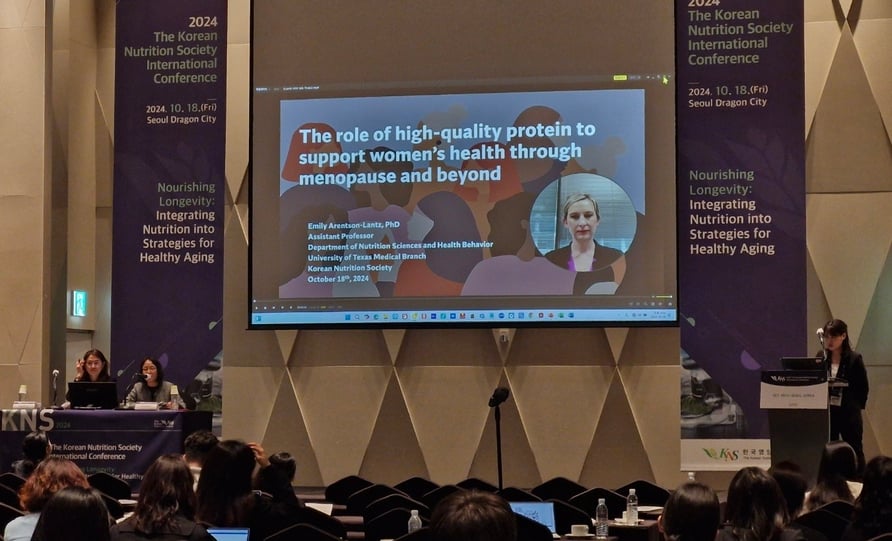
Dr. Emily Arentson-Lantz’s talk was geared specifically to how dairy protein addresses the unique needs of aging women.
Dr. Arentson-Lantz explained how high-quality protein supports women’s health through menopause and beyond—a period in which women become more vulnerable than similarly aged men to age-related muscle loss, sarcopenia, chronic disease, frailty and hospitalization. She reinforced the critical role dietary protein intake plays in the maintenance of muscle mass and function, emphasizing why the protein source (high-quality vs. low-quality) and timing of ingestion matter. The strong scores for MPC and WPI on the Digestible Indispensable Amino Acid Score (DIAAS) scale (well ahead of plant-based sources) make them ideally suited for aging women’s needs, she said.
Dr. Park spoke on the preventative effect of protein on sarcopenia, highlighting clinical trials of Korean seniors at risk for frailty and malnutrition. The trials showed that supplementing diets with whey protein can have a beneficial effect on sarcopenia.
Dr. Lee discussed the health effects of dairy protein intake and exercise, emphasizing the importance of protein quality for aiding post-exercise recovery, muscle development and healthy aging.
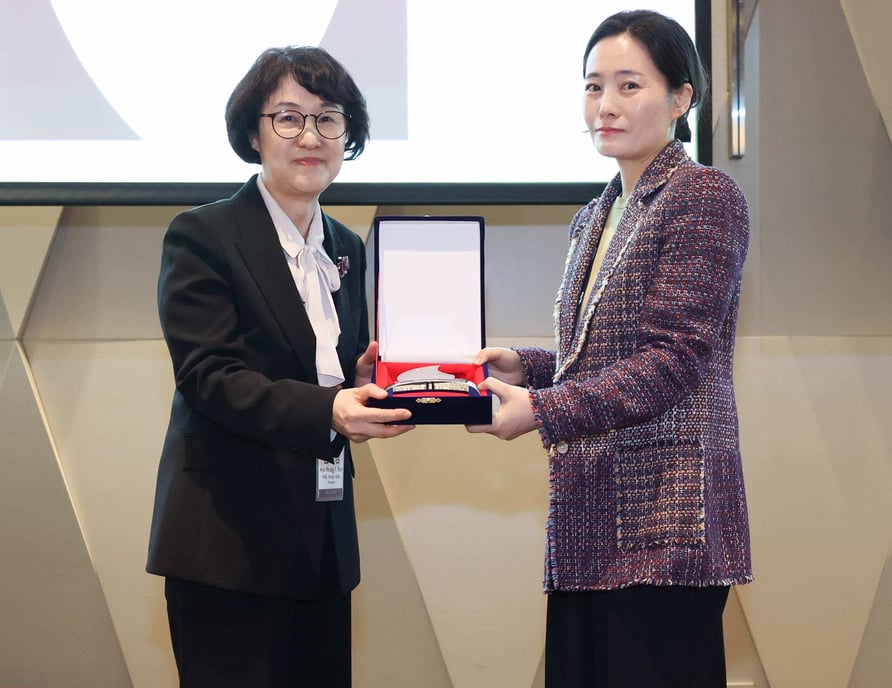
At this year’s conference, KNS awarded USDEC a plaque of recognition to acknowledge the Export Council’s long-standing support of Korean health and wellness. Claire Yoon (right), USDEC’s Korea office representative, accepted the award on USDEC’s behalf.
Indonesia extends mandatory halal certification deadline, some details remain outstanding
Indonesia's government extended the deadline for halal certificate registration of imported food and beverage products, including dairy products. Government regulation No.42/2024 regarding halal certification will allow importers and retailers time to prepare for implementation. However, while the regulation provides a deadline of “no later than” Oct. 17, 2026, for dairy products, the language is ambiguous, and the exact extension period for U.S. products is still unclear.
USDEC, FAS, and other affected stakeholders sought the extension due to numerous issues with the new halal certification process. Please see USDA’s official GAIN report for further details.
USDEC will continue to monitor the situation closely and update members as soon as additional information becomes available. Please contact Aimee Pinkerton at apinkerton@usdec.org with any questions.
Sirha Arabia provides platform for U.S. cheese exposure
USDEC recently participated in the Sirha Arabia show to increase the exposure to U.S. cheese and advance the opportunities for U.S. suppliers in Saudi Arabia’s growing foodservice sector. The show, which took place in Riyadh from Oct. 1-3, is a spin-off of Sirha Lyon, a prestigious food and hospitality exhibition taking place every two years in Lyon, France. This was the first time it was held in the Middle East.
Foodservice stakeholders from across the Saudi Arabian industry attended the show, including importers/distributors, foodservice operators, chefs, and other key food industry professionals.
The Saudi Arabia food and beverage market, already the largest in the Middle East region, is poised for continued, rapid growth. Saudi Arabia, shifting towards a more diversified, non-hydrocarbon-based economy as part of its Vision 2030 Plan, plans to invest $20 billion in the food industry by 2035 with an emphasis on expanding the tourism, hospitality, foodservice and retail sectors. In addition, several reforms initiated by the Saudi government to open the economy to the rest of the world are expected to drive further growth in the country’s foodservice sector. With this increased growth comes increased opportunities for U.S. cheese.
USDEC hosted a booth at Sirha Arabia where attendees could sample and learn about the broad portfolio of Cheeses from the USA. Additionally, USDEC staff and representatives participated in various discussions and exhibitions taking place alongside the show.
Amy Foor, vice president of global foodservice programs, took part in the Sirha Food Forum in the panel discussion, “Dairy Trade and Export: Navigating Global Markets and Challenges,” highlighting the U.S. cheese industry’s ability to fulfill Saudi Arabia’s growing cheese needs. Antonio El Khoury, director of culinary programs MENA, participated in the Sirha Food Master’s Stage, hosting a masterclass showcasing how U.S. cheese can be incorporated into local cuisine. Chef El Khoury demonstrated the preparation of a lamb and cheese mutabbaq, a stuffed bread that is a popular street food snack in Saudia Arabia.
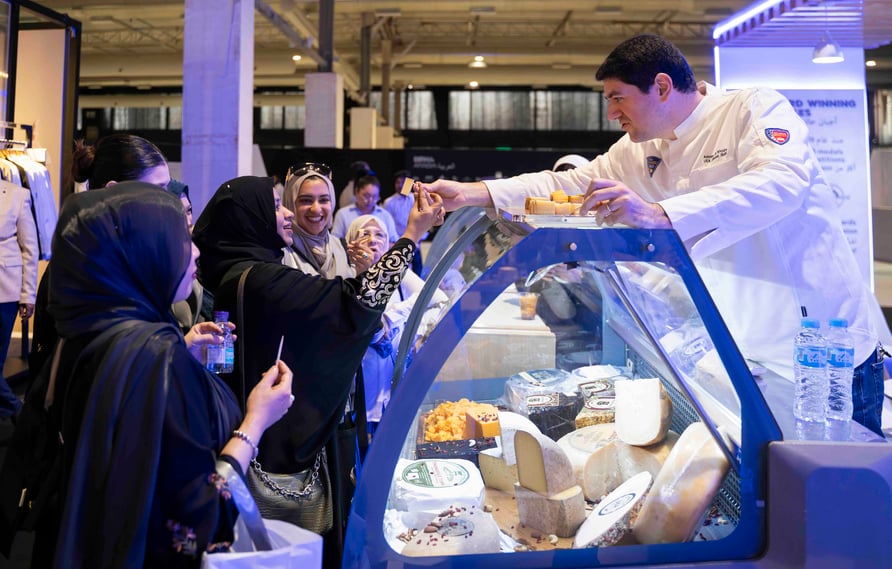
Antonio El Khoury hands out samples of U.S. cheese at Sirha Arabia.

Amy Foor (second from right) highlights U.S. cheese quality, variety and capacity to meet Saudi Arabia’s cheese needs at the Sirha Food Forum panel discussion, “Dairy Trade and Export: Navigating Global Markets and Challenges.”
Comments urge USTR to address U.S. ag trade concerns with EU
USDEC and NMPF filed joint comments with the Deputy Assistant USTR for Europe, Michael Rogers, urging the agency to engage more strategically with the EU on U.S. agricultural export concerns. The input comes in response to a USTR request for comments on the U.S.-EU Trade and Technology Council (TTC) Global Trade Challenges Working Group.
One of the stated tasks of the TTC Global Trade Challenges Working Group is “to address and counter non-market policies and practices that unfairly undermine the competitiveness of U.S and EU workers and firms.”
The comments argue that the group has failed to address the many nontariff dairy and agricultural trade barriers the EU itself has created and continues to construct. The bloc persists in introducing requirements that impose increasingly burdensome regulations on its trading partners in contrast to the much more accessible U.S. market, USDEC and NMPF note.
Among the EU’s tactics is a pattern of dictating increasingly detailed production practices at the farm level, with regulations in areas like deforestation, antimicrobials and animal welfare.
“The U.S. should pursue a more thoughtful and focused form of engagement with the EU on agricultural trade,” the comments state. The U.S. must be “more assertive in leveraging incentives in U.S.-EU trade and insisting on resolution to drive EU compliance on our export issues, particularly on agricultural topics.”
One way the U.S. and EU could facilitate trade is to collaborate on the development of an electronic health certificate, the comments suggest. Electronic certification has the potential to streamline operations, improve data sharing and benefit both the government and industry.
USDEC outlines critical role of exports at DMI Joint Annual Meeting
USDEC reaffirmed the essential role exports play in the vitality of the U.S. dairy industry at this week’s 2024 Joint Annual Meeting of the National Dairy Promotion and Research Board (NDB), National Milk Producers Federation (NMPF) and United Dairy Industry Association (UDIA) in Phoenix. USDEC President and CEO Krysta Harden spoke as part of the general-session CEO panel and USDEC COO Martha Scott Poindexter, Executive Vice President Shawna Morris and Senior Vice President Will Loux presented during the breakout session, “Trading Spaces: U.S. Dairy Export Opportunities in Global Markets.”
Key messages included:
- Global demand growth slowed from 2023 into 2024 as inflation fueled dairy prices. Some countries, particularly those that spend a more significant portion of their income on food, have been unable to absorb the higher prices. But inflation continues to ebb and demand growth has been looking more positive in recent months.
- While some global markets, like China, have seen dairy import demand decline since 2020, other key markets where the U.S. maintains a strong and growing presence—including Mexico, South America, Central America and the Caribbean, Southeast Asia, and the Middle East/North Africa—remain in growth mode.
- The lack of new comprehensive U.S. trade agreements is a headwind that U.S. exporters will have to contend with—particularly as the EU and New Zealand continue to forge ahead with bilateral trade deals of their own. USDEC is pursuing a variety of policy approaches to help mitigate the brunt of that challenge.
- U.S. dairy production and trade will be increasingly important factors in sustainably nourishing the world.
- International trade remains crucial to U.S. dairy, and USDEC is committed to working harder to engage with buyers, end-users, policymakers, regulators, international standards-setting groups and allied organizations to create opportunities for U.S. dairy suppliers.
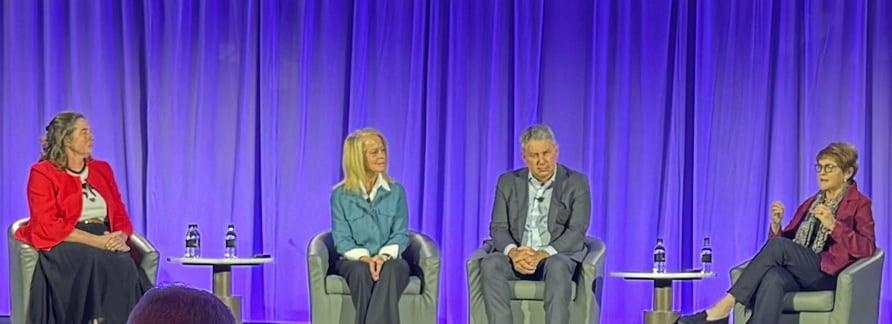
The CEO panel at this week’s Joint Annual Meeting. Left to right: Dairy farmer Joanna Shipp; Barb O’Brien, president and CEO, Dairy Management Inc.; Gregg Doud, president and CEO of NMPF; and Krysta Harden, president and CEO, USDEC.
Events
Don’t miss the All-Member Webinar to review the USDEC 2025 Operating Plan
USDEC will hold an All-Member Webinar on Oct. 31, 1:30 p.m. ET to review the 2025 Operating Plan. The plan was made available to members last week. You can download a copy of it here.
The plan outlines how USDEC seeks to increase outreach and work harder to engage with buyers, end-users, policymakers, regulators, international standards-setting groups and allied organizations to create opportunities for U.S. dairy suppliers. The webinar will provide:
- A walkthrough of the 2025 Operating Plan.
- An update on the latest export and market developments.
- First-hand accounts of how USDEC staff is addressing industry challenges.
- An inside look at programs and activities focused on the long-term growth potential of U.S. dairy exports.
Register for the webinar by clicking here. Registrants will be sent the Zoom link after signing up. There is no limit to the number of staff that may attend from a member company, so USDEC encourages all interested member representatives to register.
USDEC also encourages attendees to review the Operating Plan and jot down any questions before joining the webinar. Staff will be available to ask questions during the Q&A session at the conclusion of the event. Thank you! USDEC looks forward to your participation.
Oct. 29 deadline to apply for USDA ag trade mission to Thailand
The deadline to apply for USDA’s first-ever agricultural trade mission to Bangkok, Thailand, is Oct. 29. The event takes place on Feb. 3-6, 2025.
Participating companies will have the opportunity to meet face-to-face with potential importers from both Thailand and Burma. FAS staff and regional trade experts will provide in-depth market briefings and lead site visits. To learn more about the mission and apply to take part, click here.
Thailand boasts a population of 70 million with a growing middle class that is driving demand for imported foods. U.S. dairy export volume to Thailand more than doubled from 2018-2023, driven by low-protein whey, lactose and NFDM/SMP. U.S. shipments through the first eight months of 2024 were down 9%.
Additional 2025 USDA ag missions are being planned for Côte d’Ivoire, the Dominican Republic, Guatemala, Hong Kong, Mexico and Peru. USDEC will report on those trips as USDA releases further information. In addition, members can keep abreast of USDA’s agricultural trade missions here.
USDEC Research
USDEC’s new whey study forecasts global consumption and application volumes through 2027
USDEC’s latest custom study reveals key insights into global consumption and applications of whey ingredients, including whey permeate, sweet/dry whey, WPC and more. Led by USDEC’s Strategic Insights (SI) team, the study estimates whey ingredient volumes using publicly available data, extensive trade interviews, and multiple data sources.
To access the research:
- Email Megan Sheets at msheets@usdec.org. A member of the SI team will provide an Excel file of the topline data, along with a password for access.
- After reviewing the topline data, if you would like a more detailed breakdown of application and consumption volumes for specific markets, please email Sheets for further information.
In addition to the Whey Usage Segmentation report, USDEC has also produced two topline video summaries tailored for those less familiar with global WPC80 and WPI trends. Those videos can be viewed on Vimeo via the links below. For detailed data and insights, please refer to the full study.
New report, “Beverages Landscape in Southeast Asia,” explores opportunities for U.S. dairy ingredients
USDEC’s Strategic Insights team’s “Beverages Landscape in Southeast Asia” report uncovers key opportunities for incorporating U.S. dairy ingredients into the region’s packaged beverage market, including ready-to-drink (RTD) and ready-to-mix (RTM) applications. Healthier options, such as protein-enriched beverages, are in high demand. USDEC’s in-market outreach programs are actively pursuing these opportunities. Access the report here. Download requires a member login.
Market Summary
Chinese milk powder imports plunge in September
Chinese milk powder imports plummeted in September to their lowest monthly total in several years. Year-over-year (YOY) WMP imports dropped 45% (-8,591 MT) to just 10,372 MT. It was the worst month since June 2016. YOY SMP imports fell 51% (-9,943 MT) to 9,571 MT. Chinese SMP imports hadn’t fallen below 10,000 MT since October 2016.
YOY Chinese SMP imports have declined for 11 straight months and WMP has decreased every month since March, so the September fall was not unexpected. But the degree of the drop was somewhat surprising, given reports of steadily declining Chinese milk powder inventories through the summer (falling to multi-year lows) and slowing domestic milk production.
Most major suppliers felt the Chinese pull-back in SMP. SMP imports from the U.S. declined sharply in September (-84%, -1,719 MT), but Australian volume plunged 75% and imports from New Zealand slipped 13%. China’s largest WMP suppliers—New Zealand and Australia—were hardest hit by the WMP decline.
On the plus side, Chinese cheese imports rebounded slightly in September after four straight YOY declines. Volume increased 6% (+705 MT), with New Zealand being the biggest beneficiary (+26%, +1,653 MT).
WPC80+ imports posted their seventh double-digit YOY gain in the past eight months. Volume rose 24% (+757 MT). Imports from the U.S. increased 8% (+102 MT), but purchasing from the EU soared (+79%, +892 MT).
Through three quarters of the year, Chinese dairy import volume (major products, not including fluid) was down 13% or nearly 200,000 MT. Whether the country’s recent stimulus package ultimately delivers a consumption boost as hoped remains unknown—but it would be a welcome development for global dairy markets.
Trade Policy
New Zealand escalates continued trade dispute with Canada
The New Zealand government escalated its long-running trade dispute with Canada over access for New Zealand dairy products. The Kiwi government notified the Canadian government and other members of the Comprehensive and Progressive Agreement for Trans-Pacific Partnership (CPTPP) that it had triggered mandatory negotiations in the dispute.
New Zealand won a CPTPP trade dispute over Canada’s tariff rate quota system in September 2023. An independent panel found that Canada’s dairy TRQ administration was inconsistent with its obligations under the CPTPP. New Zealand claims that Canada has since failed to rectify the situation, prompting the new challenge. Under the CPTPP dispute settlement process, these negotiations must begin within 15 days of notification. (Radio New Zealand, 10/18/24)
Company News
Almarai launches cheese production lines in Egypt
Saudi Arabian food and beverage company Almarai opened two new cheese production lines at its Beyti subsidiary in Egypt. A company statement said the investment of nearly EGP 1 billion (about US$20 million) aligns with the company’s strategic vision to expand its regional footprint and underscores Almarai’s commitment to meet rising demand for cheese products and supporting the Egyptian economy. Almarai’s CEO also said the company is “committed to delivering high-quality products that meet the needs of consumers in Egypt and abroad.” The company said it aims to generate US$50 million in exports through its Beyti subsidiary to fuel its global growth. (USDEC Middle East/Egypt Office; Company reports)
Pure Ice Cream announces plans for Dubai factory
UAE-based dessert maker Pure Ice Cream announced a deal to build an AED80 million (about $22 million) factory at Dubai Industrial City. The company, which manufactures brands such as Kwality and Hershey’s ice cream, said the facility will be built within the dedicated food and beverage zone of Dubai Industrial City and is expected to be among the UAE’s largest ice cream factories upon completion in 2026. It will triple Pure’s annual capacity to 30 million liters, supporting ambitions to grow its regional and international footprint and fortify its presence in the UAE’s food and beverage manufacturing sector. The new facility will support Pure Ice Cream’s network in key markets across the GCC, Africa, Southeast Asia and the United States. (USDEC Middle East/North Africa office; Arabian Business, 10/21/24)
Company briefs
Synlait Milk CEO Grant Watson, who has held the title since January 2022, resigned effective immediately. The New Zealand company’s board is planning a global search to fill the position. In the meantime, Tim Carter, current CEO of Synlait’s Dairyworks business, has been appointed acting CEO. … In its first investment outside of America, Ohio-based Great Lakes Cheese announced a strategic partnership with Australia’s Pure Dairy. A Great Lakes Cheese official said the partnership will allow the company to support Pure Dairy’s continuing global expansion efforts. … Chick-fil-A plans to invest $75 million over the next decade to support its expansion to Singapore. The company expects to open its first outlet in Singapore by late 2025. ... In a move to meet growing national demand for its products, Arizona-based dairy company Shamrock Farms said it is investing $59 million to expand its milk manufacturing facility in Virginia. The project, which is expected to be complete in 2028, includes adding a new production filling line and cold-storage space at the site. (Company report; Dairy News Today, 10/22/24; Just Food, 10/17/24; Restaurant Dive, 10/17/24)
In Case You Missed It...
U.S. Dairy Exporter Blog
Market analysis, research and news subscribe hereUSDEC Twitter feed
Follow us here.